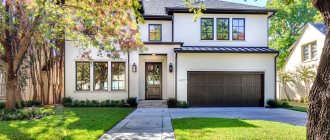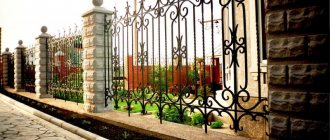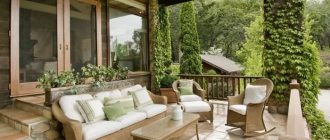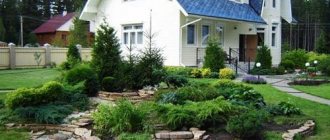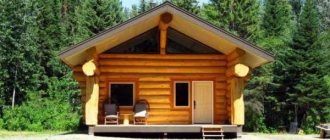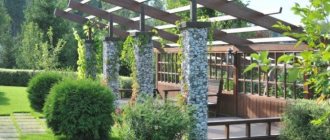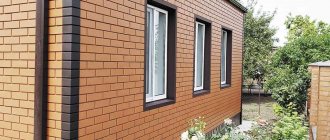Photo: repairstyling.com Among all finishing materials, decorative plaster occupies a special place. Since its appearance, it has not lost ground for a season, but on the contrary, more and more interesting options are appearing. In the same way, bark beetle plaster appeared at one time, which has now deservedly become a classic in interior design and facade decoration. Let's tell you more!
Characteristics of the "Bark Beetle"
The material does not require high qualifications when working with it, is in no way inferior to other finishing materials during operation and gives the house an exquisite appearance. In addition, its texture allows you to hide defects in wall coverings.
The base of the plaster is gypsum or acrylic. Packaged in the form of a ready-to-use mixture or powder. Marble chips with a grain size of 0.08-0.35 cm are added to the mixture. This component gives the coating a grooved relief.
Most often, this plaster is used to cover the façade of a house. The color of the material is light shades, so after plastering the facade is painted, choosing a color to taste.
How to properly coat the surface?
The whole process is divided into two stages. Let's look at the nuances:
Work is carried out from the bottom corner on the right side, gradually moving to the top, carefully leveling the material over the surface. It is necessary to ensure the formation of a layer the size of a liquid granule. To do this, focus on the grooves or scratches that appear.
You can use a spatula and grater at 60 degrees relative to the surface. After completion, you need to wait until the material dries to begin forming the desired texture.
The selected texture option is easily created with a grater or plastic trowel. Any of the tools is pressed against the material and pressed slightly into it. The required pattern will be formed using the master’s dexterity of movements using the prepared material:
Using intermittent circular movements with a grater, you can form the classic shapes created by a beetle on a wood base. To do this, you need to press the tool a little and use circular or arcuate movements in all directions to create a pattern.
The pattern called “travertine” is created based on short and slightly jerky movements. They must be performed using a trowel, moving it in all directions in order to create an imitation of the presence of a stone.
To create a pattern called “cork” you will need a polystyrene foam trowel. To do this, intensive circular movements are performed in one direction. It is recommended to maintain a small radius of movement of the tool.
An imitation of fabric texture is created using cross-shaped movements of a grater. The tool moves from bottom to top based on average speed. Horizontal lines are applied with one quick stroke.
You can form a pattern called “rain” using continuous diagonal movements from top to bottom, starting from the top right side to the bottom left side.
Important: When the work is finished and a full-fledged pattern has formed, it is necessary to erase the unsightly places at the joints and slightly level the entire surface without significant pressure on the pattern.
In general, imitating a surface similar to the natural version created by a beetle on a tree is not particularly difficult. Domestic craftsmen most often use Ceresit bark beetle plaster, since it is offered on the basis of many types, and it is always easy to select the necessary finishing material. You can work with it on walls, facades or ceilings.
If it is difficult for you to choose the necessary material for one of your design ideas, you can use a catalog of bark beetle plaster in the interior from a popular brand or a reputable store. Thus, you can quickly find what you want to see on the surface outside or inside the building. We hope that you will have excellent results after using this finishing material. And you will often resort to his help.
Material advantages
- Mechanical strength and no harm to the environment. The starting components of plaster are only natural materials.
- Light weight. Reduces the load on the supporting structures of the house due to light mineral fillers.
- The ability not to lose strength, moisture-proof and color characteristics over a long period of operation.
- Fire resistance, ability to withstand open fire.
- Variety of colors. Choosing the right bark beetle color for the facade will not require significant labor costs. Ability to resist mold fungi.
- Attractive prices and a wide range of pricing solutions.
How to choose the right insulation thickness
In order not to make a mistake with the choice of insulation thickness, you should use special programs. For example, there are calculators online for calculating the thickness of thermal insulation. One of them is here. It takes into account many parameters, and even relies on the climatic conditions of various Russian cities.
The proposed fields must be filled in, indicating the desired temperature in the room, the type of room and structure, and the dimensions of the building. By clicking the “perform calculation” button, the program will display the desired figure.
In general, there are standards for each region.
· Moscow – 120 mm
Chelyabinsk – 130 mm
Kemerovo – 140 mm
· Sochi – 90 mm.
Disadvantages of the material
- If the coating is damaged, it is very difficult to repair it. To do this, it is necessary to remove the damaged layer of plaster and reapply it.
- Application technology requires professionalism. In this case, a special trowel is used.
- It is quite difficult to remove contaminants from a surface plastered with “Bark Beetle” and having a complex topography.
Technology of painting decorative plaster
To paint bark beetles, follow these recommendations:
Preparatory work
Preparing the surface for painting involves allowing the finish to dry completely - however, it is not possible to strictly indicate the time, since different types of plaster harden at different times. Therefore, this may take 8 hours or several days - after this the surface must be primed and left to dry.
Disadvantages of the bark beetle
- Such a surface is very difficult to repair, since the texture and color at the site of mechanical damage are very difficult to restore
- All work has seasonal restrictions, since finishing cannot be carried out under certain humidity and temperature conditions
- If the technology for applying paintwork is violated, problems such as swelling, color inhomogeneity, etc. may occur.
It is also not recommended to use cheap materials, since after a few years they will lose their appearance, and the facade will need decorative repairs.
Painting the bark beetle in two colors
When painting decorative plaster in two colors, the shades of the first and second layers of paint are different. In this case, the first layer can be either lighter or darker - it depends on the desired effect.
Varieties of "Bark beetle"
Manufacturers offer two types of bases - gypsum and acrylic.
The acrylic-based mixture is applied using special technologies and requires a professional approach. This composition fits well on concrete and surfaces made of cement-bonded particle boards.
Painting acrylic-based plaster requires the use of computer technology and special machines. May contain mineral chips, the grain size of which is 0.1-3.5 mm.
Manufacturers guarantee the service life of such coatings for at least 15 years. After drying, it becomes resistant to adverse external influences.
The color of the coating is selected in advance, after which painting is not required. However, applying such a coating requires special knowledge and experience.
Gypsum-based bark beetle is more economical and less difficult to use. To work, you need to prepare a solution by mixing the dry composition with water.
It is applied to the walls manually, and no high qualifications are required, that is, finishing the facade with your own hands is quite simple. The material is durable, and its price is not high.
There are two varieties of bark beetle. The binder can be silicate or silicone compounds. The first is characterized by resistance to microorganisms and vapor permeability. The second is chemical resistance.
Peculiarities
For this reason, it is not for nothing that bark beetle plaster is considered a finishing material unique in its qualities. When applied to the base, you will get a surface with many grooves, pits and stripes. Thanks to the interesting texture, you can easily hide all the imperfections of the walls, as well as disguise small surface irregularities.
This plaster is available on a gypsum and acrylic basis and is available in the form of a ready-to-use mixture or in the form of a dry powder. The granular structure gives the coating an unusual design, since the composition contains fine marble chips. The grains can vary in size (from 0.08 to 0.35 cm), depending on which larger or smaller grooves will be obtained.
Please note that with the help of this plaster you can create an unusual coating for any surface. It is in great demand when performing external work when cladding the facade. Usually the material is white or gray, so you can give the desired shade only after applying the mixture and drying it, and then you can paint it.
Advantages and disadvantages
The main advantages include the following:
- Environmentally friendly and high strength. The material is made only from natural raw materials, and thanks to a special production technology you get a coating that is reliable in use.
- Light weight. Another advantage, as this will reduce the level of mechanical load on the entire structure. The mineral fillers included in the composition make the material light, which is also a plus.
- Resistance to external influences. Bark beetle plaster tolerates direct sunlight and temperature changes, and is also not afraid of moisture. In addition, the finish will not fade in the sun and lose its original appearance throughout the entire period of use.
- Resistant to mold and mildew. Thanks to the special composition, the surface will be reliably protected from various microorganisms.
- Fire resistance. The material has a low ignition coefficient.
- Wide range of colors. Even though the base color of the material is white or gray, you can always make color adjustments.
- Reasonable price. The market is full of products from foreign and domestic manufacturers, and you can purchase material at
Flaws
If we talk about shortcomings, then there are enough of them. The “bark beetle” finish for the façade of a private house deteriorates when subjected to serious mechanical loads, and this is difficult to correct. To restore the appearance, you will need to do the cladding from scratch and remove the damaged coating. It is also not easy to use such plaster, since you need to know a special application technology. Usually, to complete complex decorative elements, one cannot do without the help of specialists.
Important! Not everyone can do everything at the proper level, as there are special subtleties. For example, you will need a special trowel. And the grooves do not appear on their own, but by moving the tools up and down. After this, the layer needs to be smoothed a little. The difficulty of cleaning the surface is also important. In the future, dust will get into the furrows, and it will not be easy to remove it from there.
Varieties
“Bark beetle” as a decorative plaster is presented on the construction market in 2 varieties, namely, it is based on acrylic and gypsum. The acrylic-based mixture is applied using a special technology, due to which the facade gains its attractiveness. But to create a visually rich decor, you will need to take into account various finishing nuances. You can purchase the material in buckets of different sizes. The mixture can only be applied to walls made of fiberboard, as well as to a concrete base.
To give acrylic plaster color, you need to use a tint. Usually you cannot do this without the help of computer technology, since it is difficult to achieve the desired color manually. The material contains abrasive granules, and this is in addition to the fact that it contains marble chips or minerals. The grain size directly depends on the size of the abrasive and ranges from 0.01 to 0.35 cm.
The service life of this coating is up to 17 years. Thanks to the unique structure of finishing the house facade with bark beetle plaster, application of the mixture will be ideal, and after drying it will not crack. In addition, high adhesion of the material is noted. To obtain any shade of plaster, you do not need to additionally paint the facade. The only disadvantage of acrylic-based plaster is the difficulty of application.
Interestingly, a similar material, but on a gypsum basis, is simpler and more economical in consumption. The difficulty when working is that before using it you need to prepare the solution yourself and mix the powder with water. But we also note that gypsum plaster is made from environmentally friendly raw materials and is easy to apply manually. This material is inexpensive and very durable.
Depending on the type of binding component in the plaster, bark beetle is divided into silicone and silicate. The latter option is produced on the basis of liquid glass, and is characterized by microbiological resistance and vapor permeability. Silicone plaster is made from acrylic modified substances and silicone resin. It is chemical resistant and is often used when working with stone.
Color palette
To add brightness to the design, you need to tint the mixtures. Gypsum-based materials are much easier to paint, since it is a dry mixture, and the required amount of dye can be added at the mixing stage. Acrylic plasters are more difficult to tint and getting the desired color is not so easy. When dyeing, be careful not to make the shade too saturated.
But in general, it is not at all necessary to paint, since the plastered surface can be coated with enamel on the same base as plaster. At the moment, warm shades of the palette have taken leading positions in modern facade design. The decoration of the facade of the house with “bark beetle” in red, yellow, beige and brown shades looks great in the photo. The color of the facade should be selected taking into account the design style of the land plot. An excellent option for country houses would be green or gray cladding, while a monochromatic design is not necessary; ideally, the composition should consist of several shades.
Coloring
In the case of gypsum-based plaster, any coloring substance can be added to the dry mixture. If the plaster is acrylic-based, then painting should be done with great care, otherwise the color may be overly saturated.
After plastering, the surface can be coated with enamel on a base similar to plaster. Today, brown, beige and yellow colors are popular.
However, the color of the house should be in harmony with the color scheme of the entire site. Experts recommend using several colors when painting your home, including gray and green.
How to remove old plaster?
It is necessary to remove old plaster only in case of poor adhesion to the base. You need to make sure what type of plaster is: cement or lime? Limescale must be removed without regret. If the cement holds tightly, there is no need to remove it.
Removing old plaster
Tip: Check the quality by lightly tapping the wall with a hammer. If the sound is dull, it means the layer has fallen behind the brick base and will fall off over time. Such areas must be removed and plastered again.
Plaster is removed in two ways:
- manually with a chisel, hammer, scraper, spatula;
- mechanical hammer drill or grinder with a diamond wheel.
We resort to using a hammer drill
In both cases it is necessary to get to the base. The final stage is cleaning with metal brushes manually or with a grinder, removing dust with a wet cloth or vacuum cleaner.
Popular manufacturers
Ceresit, Baumit and Dufa are the most popular among consumers. The use of plaster from these manufacturers does not require high qualifications and time spent on preparing the mixture.
The plaster of the Unis consortium, which also includes domestic manufacturers, is particularly successful. It is produced both in the form of a dry mixture and in a ready-to-use form. Resistant to fungi, ultraviolet radiation and frost.
Concrete tiles
Facade concrete tiles look beautiful. For any architectural buildings, be it the external walls of a country cottage or the facade of a country house, this will be an excellent solution. High quality, looks very similar to natural stone. An even texture will make it possible to do the work neatly. A variety of colors will allow you to decorate your home to your taste.
Includes:
- sand;
- cement;
- plasticizing additives;
- mineral-based powder, which is a replacement for ash and cement.
Concrete tiles are a very high quality product. In appearance and properties it resembles natural stone. Unknowing people will not be able to feel the difference even by touch. The feeling that you are holding natural raw materials in your hands is due to the uneven surface. Relief is achieved under the influence of high-frequency vibration (the mold filled with raw materials is placed on a vibrating table). To achieve a higher quality of installation, you need to choose the most even rectangles.
Consumption rates
Before work, you should calculate the amount of mixture required as accurately as possible. Otherwise, the excess will become unusable, and the deficiency will lead to a disruption in the texture when the solution is re-applied.
It should be noted that if the wall is uneven, then the layer of plaster must be increased. The packaging of the mixture always indicates the approximate consumption, on average it is up to 3 kg per 1 sq. m. m of surface.
DIY bark beetle plaster
Be sure to prepare the mixture strictly according to the recipe on the package so as not to spoil the plaster. To dilute the dry part, slowly add warm running water. To mix without lumps, use a construction mixer or a drill attachment.
Before use, leave the mixture to rest for a quarter of an hour, and then beat again. You will end up with a solution that resembles the consistency of mashed potatoes. It is important not to overdo it with the amount of water, because otherwise the mixture will separate.
DIY decorative plaster: 8 ways to do it
Coating technology
Finishing the facade is the final and most important stage of construction, because the impression of the house depends on it.
Stages of work:
- Installing beacons and leveling the surface.
- Primer. A solution with increased adhesion is considered the best.
- Facing. This is done with a spatula. Preference should be given to coarse-grained compounds
- Areas not to be covered are covered with masking tape.
- Creation of the required texture. It is created with a special grater, which is used to process the wet surface of the plaster. The process is similar to conventional puttying, but in our case the solution is “smeared” until grooves form. If it sticks to the grater, the mixture must be allowed to dry.
- Varnish coating. Gives the surface an attractive appearance and protects it.
Pros and cons of facade plaster
pros
- The application method is very simple. A person without certain skills will be able to cope with such work on his own;
- environmental cleanliness;
- texture, colors, application methods are very different;
- aesthetics and quality;
- resistance to strong external influences and durability;
- unpretentious operation.
Minuses
- complete finishing takes significantly more time and energy consumption - the reason for hiring special teams;
- does not last as long as clinker, brick, ventilated facades;
- the material is selected more carefully depending on the surface and material of the walls;
- if workers do not follow the technology, the plaster will not last so long, and the main wall, for example made of aerated concrete, may partially collapse.
Finishing
Bark beetle finishing is mainly used in low-rise construction. This finishing method allows you to give the building a unique look.
To make an error-free choice of coating technology and design, it is recommended to familiarize yourself with photos of beautiful bark beetle facade decoration posted on the Internet. For example, giving the house an "antique" feel. To do this, use plaster of dark colors and create the appropriate surface texture. The effect can be enhanced by a brick plinth, columns and a wide staircase.
A classic design will require understated elegance and simplicity. The coating is carried out with acrylic plaster of light colors. A tiled roof and brick gazebos will complete the impression.
For small buildings, a combination of plaster with natural materials is recommended. For example, inserts made of wood and natural stones harmonize well with a tiled roof, flower beds and shell paths.
Designers recommend plastering all loggias and terraces in the same way, but using different colors. This will highlight every architectural detail of the building and emphasize its individuality. At the same time, they stick to brown and light beige shades. Each floor of the house can be painted in different colors, and a wide staircase with carved railings will give the building an original and attractive look.
Preparing the mixture
Construction mixtures are prepared according to the instructions. They are diluted with water, which is preheated to 20 degrees.
Figure 3. Ready-made building mixture.
How to properly mix the decorative mixture?
To avoid the appearance of lumps, stir the plaster with a construction drill. Immediately after preparing the solution, it is applied to the wall.
Bark beetle mixture consumption
During finishing work, the material is simultaneously applied to the entire wall, so the mixture is calculated first. On average, 3 kilograms of material are used per 1 square meter. This figure is multiplied by the area of the wall.
Methods for staining bark beetles
Several methods of staining bark beetle . You can add color to the mixture, which will ensure color stability. If the plaster is not pre-tinted, then it is painted with paint after drying.
Color and appearance of plaster
The façade finishing technology involves using a variety of colors. The original option is deep painting of the base with all the cracks and depressions, rather than surface painting of the walls. You can finish decorative panels that use a dark color. The wall itself is painted in a lighter shade.
Photo of facade decoration with bark beetle
Why is mineral wool so popular?
Along with foamed and extruded polystyrene foam, mineral wool is popular for external insulation.
· This material has one of the lowest thermal conductivity values, that is, a house lined with mineral wool resembles a thermos.
· Both glass wool and basalt wool do not absorb moisture. This means that the walls of the house do not become damp, and conditions are not created for the formation of mold and mildew.
· Alkalis and acids do not affect the material in any way.
· The material “breathes”, positively influencing the microclimate in the house.
· The special fibrous structure of mineral wool provides it with increased sound insulation properties.
· The material does not support combustion.
· Even when heated, mineral wool from proven brands does not emit harmful compounds.
· The material does not shrink.
· Stone wool is the most durable among analogues and can withstand significant loads.
At the finish line
After drying, the coating is treated with sandpaper. For acrylic plaster with dye, this is where all manipulations end.
Cement-based plaster is additionally painted to enhance its decorative effect. It is better to do this with water-soluble acrylic or silicone paints. The walls are cleaned of dust remaining from sanding and covered with a layer of deep penetration primer. Painting is done in 2 layers: first with vertical, then horizontal strokes.
Tip: a proven technique when painting this type of decorative plaster is a combination of 2 shades, for example, pink and red. For the first layer, a fluffy roller is good, painting over all the irregularities. Then a thin rubber spatula is used to create two layers of a lighter tone. The result is a non-standard façade color scheme.
The peak of popularity of this decorative plaster has not yet passed. It has many prospects that will unfold as individual housing construction develops.
